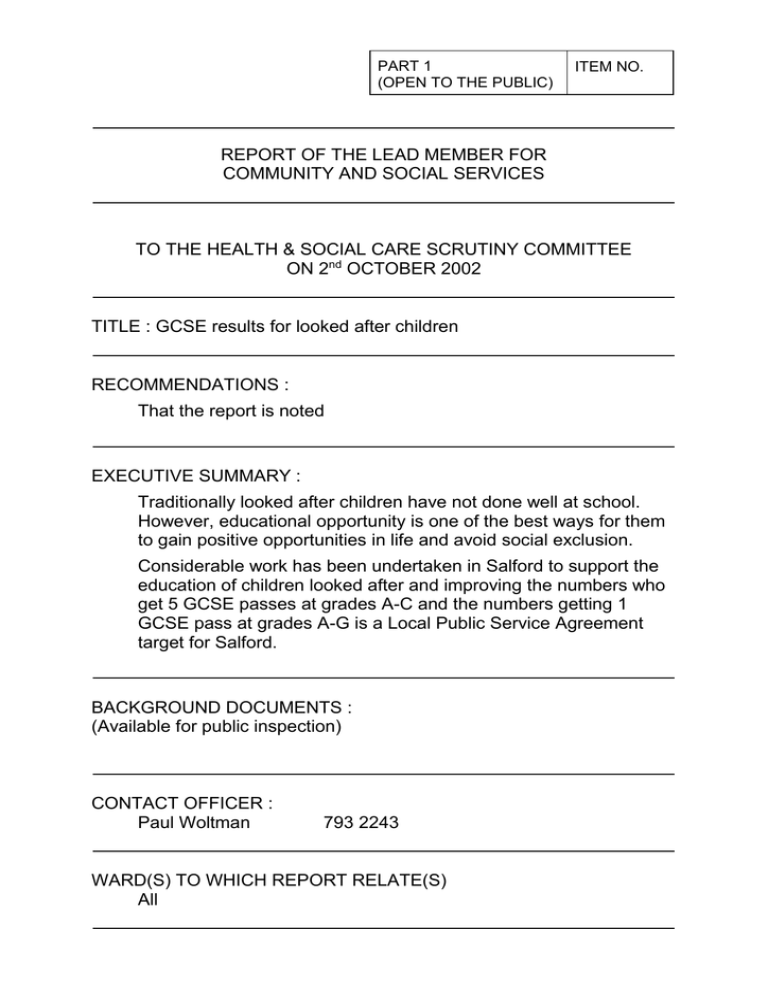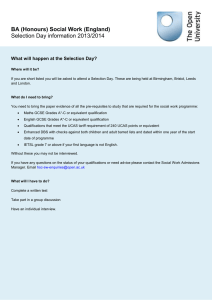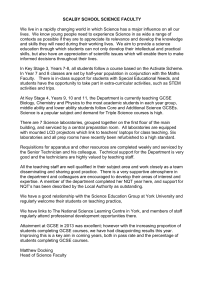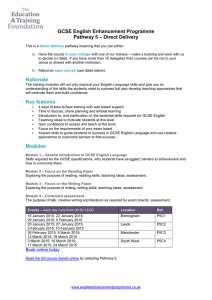REPORT OF THE LEAD MEMBER FOR COMMUNITY AND SOCIAL SERVICES
advertisement

PART 1 (OPEN TO THE PUBLIC) ITEM NO. REPORT OF THE LEAD MEMBER FOR COMMUNITY AND SOCIAL SERVICES TO THE HEALTH & SOCIAL CARE SCRUTINY COMMITTEE ON 2nd OCTOBER 2002 TITLE : GCSE results for looked after children RECOMMENDATIONS : That the report is noted EXECUTIVE SUMMARY : Traditionally looked after children have not done well at school. However, educational opportunity is one of the best ways for them to gain positive opportunities in life and avoid social exclusion. Considerable work has been undertaken in Salford to support the education of children looked after and improving the numbers who get 5 GCSE passes at grades A-C and the numbers getting 1 GCSE pass at grades A-G is a Local Public Service Agreement target for Salford. BACKGROUND DOCUMENTS : (Available for public inspection) CONTACT OFFICER : Paul Woltman 793 2243 WARD(S) TO WHICH REPORT RELATE(S) All KEY COUNCIL POLICIES: DETAILS This report provides details of the exam results for young people who took GCSE examinations in the summer of 2002. These are not themselves Performance Assessment Framework or Best Value performance indicators. Those measure the examination performance of young people over 16 who leave the looked after system each year. Nevertheless, improving year-on-year results will lead to overall improvement and better opportunities for young people leaving the looked after system. Of 37 young people eligible to take GCSE’s results are available for 36. The other member of the group lives with carers in Scotland and we have not been able to get data for him yet. The Scottish exam system is slightly different from the English one. 2002 Number in Year 11 & eligible for GCSE exams of these, the number who :sat at least one GCSE examination gained 1 GCSE at grade A* to G gained 5 GCSE's at grade A* to G gained 5 GCSE's at grade A* to C 2001 37 45 26 70.3% 26 70.3% 22 59.5% 2 7.7% 25 55.6% 25 55.6% 16 35.6% 3 6.7% Compared with 2001, there were fewer looked after young people eligible to sit GCSE’s (the looked after total has fallen). However, a higher proportion actually did sit the exams (70% against 56%). Everybody who sat an exam gained at least one pass at grades A-G. 59% gained 5 passes at grade A-G (up from 36%). One less young person gained 5 GCSE’s at grades A-C, but because a smaller number were eligible to take the exams this represents a proportionate improvement. The two with more than 5 passes at grades A-C gained 9 and 7 passes at that level respectively, an excellent performance in both cases. National and regional comparative data is not yet available but in previous years Salford has done well in numbers gaining 1 GCSE at A-G and 5 at A-G, but has not performed well in numbers getting 5 at grades A-C. The work plan for the Local Public Service Agreement (which would not have had an impact on this group because they were taking their GCSEs as the action plan was being developed) has identified all young people due to take GCSE’s in 2003, 2004 and 2005. They will be tracked and offered additional study support to help them do as well as possible. This will be in addition to work already done by the coordinating teacher for children looked after and the Education and Leisure and Community and Social Services directorates working together to establish a nominated teacher for looked after children in each school, provide inter-disciplinary training and mentoring. 2002 will be the third year in which we have held an award ceremony for young people who have made good progress in their education, with certificates presented by the Mayor. The LPSA targets are as follows: The number of children and young people aged 16 and over who leave care with 5 GCSEs at grade A* - C The number of children and young people aged 16 and over who leave care with 1 GCSE at grade A* - G 2003/4 2004/5 2005/6 4 6 9 26 32 33 The young people who leave the looked after system in 2003/04 will have taken GCSE exams in 2002 or 2003. Thus the target for 5 GCSEs at grades A-C is half-way met and the target for 1 GCSE at grades A-G is fully met. The success achieved here represents hard work by staff from Education and Leisure and Community & Social Services, but also great effort by young people, some of whom have achieved educational success whilst struggling with many personal and family problems.







